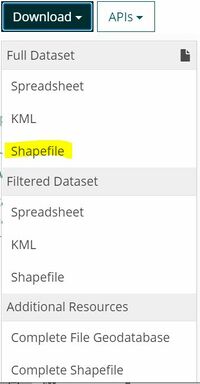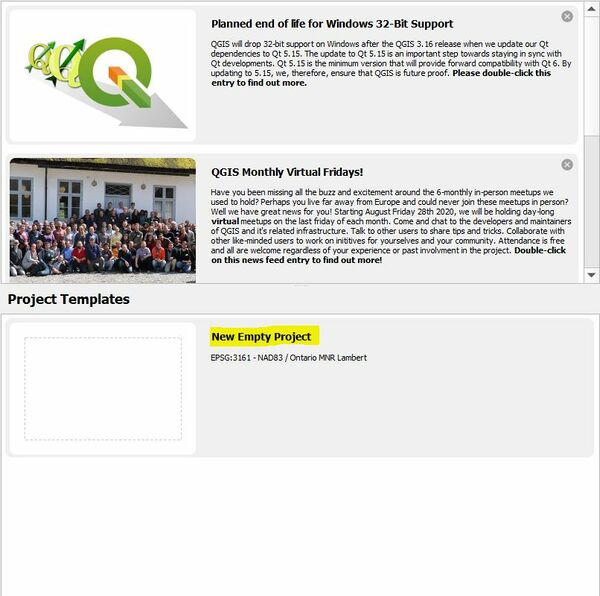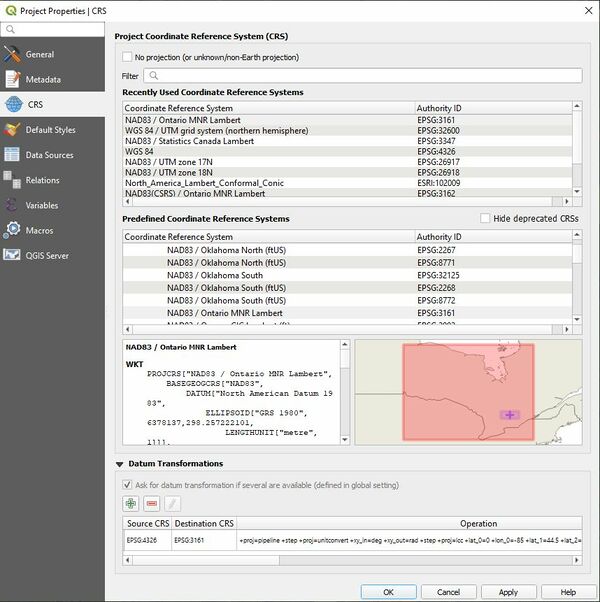Difference between revisions of "Habitat Analysis using QGIS 3.22 and QuickMapServices Plugin"
TylerCoade (talk | contribs) (Created page with "=Purpose= The overall objective of this tutorial is to develop the spatial analysis and cartographic skills within the open-source software QGIS 3.10. By using the QuickMapSe...") |
TylerCoade (talk | contribs) |
||
| Line 36: | Line 36: | ||
**Digital Elevation Model of Ontario [https://geohub.lio.gov.on.ca/datasets/mnrf::provincial-digital-elevation-model-pdem] |
**Digital Elevation Model of Ontario [https://geohub.lio.gov.on.ca/datasets/mnrf::provincial-digital-elevation-model-pdem] |
||
**Road Network within Ontario [https://geohub.lio.gov.on.ca/datasets/mnrf::ontario-road-network-orn-segment-with-address] |
**Road Network within Ontario [https://geohub.lio.gov.on.ca/datasets/mnrf::ontario-road-network-orn-segment-with-address] |
||
| + | |||
| + | |||
| + | [[File:Figure2OntarioGeohub.jpg|200px|thumb|left|Ontario Geohub Download options]] |
||
| + | *Download options available within Ontario GeoHub. These options can be accessed once a dataset is selected within the website and these options can be found on the right side of the website. |
||
| + | |||
| + | |||
| + | |||
| + | |||
| + | |||
| + | |||
| + | |||
| + | |||
| + | |||
| + | |||
| + | |||
| + | |||
| + | |||
| + | |||
| + | |||
| + | |||
| + | |||
| + | |||
| + | |||
| + | |||
| + | |||
| + | |||
| + | |||
| + | |||
| + | |||
| + | |||
| + | |||
| + | |||
| + | |||
| + | |||
| + | ==Organization of Shapefiles within your Computer== |
||
| + | |||
| + | After you have downloaded all of the required files, it is strongly recommended to create a new folder within your C: drive that will act as a main directory for the project. This is very important as we will be dealing with a large number of shapefiles that will be changed in many different ways. This folder will also become the working directory and saving location for the project as a whole, therefore it will keep everything compact and easily accessible. |
||
| + | |||
| + | |||
| + | ==Setting up QGIS for Habitat Analysis== |
||
| + | You can now open up QGIS for the first time as there will be an icon located on the desktop of your computer. You will be prompted by three different options within the middle of the screen and you will need to select “New Empty Project” (See figure 3 for screenshot of this action). |
||
| + | |||
| + | [[File:Figure3QGISStartup.jpg|600px|thumb|left|QGIS Start-up Screen]] |
||
| + | |||
| + | |||
| + | |||
| + | |||
| + | |||
| + | |||
| + | |||
| + | |||
| + | |||
| + | |||
| + | |||
| + | |||
| + | |||
| + | |||
| + | |||
| + | |||
| + | |||
| + | |||
| + | |||
| + | |||
| + | |||
| + | |||
| + | |||
| + | |||
| + | |||
| + | |||
| + | |||
| + | |||
| + | |||
| + | |||
| + | |||
| + | |||
| + | |||
| + | |||
| + | |||
| + | |||
| + | |||
| + | |||
| + | |||
| + | |||
| + | |||
| + | |||
| + | |||
| + | |||
| + | |||
| + | |||
| + | |||
| + | |||
| + | |||
| + | |||
| + | |||
| + | |||
| + | *Screenshot indicating which option you are required to select when beginning a new project within QGIS 3.10. This option should always be selected when beginning any new task. |
||
| + | |||
| + | |||
| + | ==QGIS Coordinate Reference System Settings== |
||
| + | Prior to importing your shapefiles into QGIS, you are required to set a projected coordinate system for your new project file. In this case, all of the data being used was accessible made accessible through the Ministry of Natural Resources therefore we will be using their projected coordinate system known as “NAD83/ Ontario MNR Lambert”. This will ensure all of our analysis will be accurate and measured within useable measurements. This menu can be accessed by the following path within the top menu of QGIS: Project -> Properties -> CRS. Please see screenshot below for reference when setting up your CRS within QGIS 3. |
||
| + | |||
| + | [[File:QGISCRS.jpg|600px|thumb|left|QGIS Coordinate Reference System Setup]] |
||
Revision as of 11:20, 11 December 2020
Contents
Purpose
The overall objective of this tutorial is to develop the spatial analysis and cartographic skills within the open-source software QGIS 3.10. By using the QuickMapServices plugin, users should be able to see the applicability of the add-on and be able to use it going forward in their own mapping careers. This tutorial will follow a step-by-step process that will determine ideal habitat locations for a hypothetical animal within Algonquin Park Ontario. With all of the data being open-sourced and QGIS being free, the entirety of this tutorial can be completed by anyone with a well-functioning computer or laptop.
Data Management and Setup
Required Programs and Plugins (Windows 64-Bit)
- The following programs are required to complete the tutorial. Please visit the URL’s attached and follow the steps to successfully install QGIS 3.10 (long-term release) along with the Open Layer Plugin. Please note: the following tutorial is being completed on a computer using Windows 10 as its OS.
Download Links
- 1) QGIS 3.10 [1]
- 2) QuickMapServices Plugin
Data Management for the Tutorial
- Data being used are all accessible through Ontario GeoHub. When downloading the datasets, be sure to select the shapefile option within Ontario Geohub as this will be the format that we will be using later on in our tutorial (See figure 2 for additional context)
- Download options available within Ontario GeoHub. These options can be accessed once a dataset is selected within the website and these options can be found on the right side of the website.
Organization of Shapefiles within your Computer
After you have downloaded all of the required files, it is strongly recommended to create a new folder within your C: drive that will act as a main directory for the project. This is very important as we will be dealing with a large number of shapefiles that will be changed in many different ways. This folder will also become the working directory and saving location for the project as a whole, therefore it will keep everything compact and easily accessible.
Setting up QGIS for Habitat Analysis
You can now open up QGIS for the first time as there will be an icon located on the desktop of your computer. You will be prompted by three different options within the middle of the screen and you will need to select “New Empty Project” (See figure 3 for screenshot of this action).
- Screenshot indicating which option you are required to select when beginning a new project within QGIS 3.10. This option should always be selected when beginning any new task.
QGIS Coordinate Reference System Settings
Prior to importing your shapefiles into QGIS, you are required to set a projected coordinate system for your new project file. In this case, all of the data being used was accessible made accessible through the Ministry of Natural Resources therefore we will be using their projected coordinate system known as “NAD83/ Ontario MNR Lambert”. This will ensure all of our analysis will be accurate and measured within useable measurements. This menu can be accessed by the following path within the top menu of QGIS: Project -> Properties -> CRS. Please see screenshot below for reference when setting up your CRS within QGIS 3.



